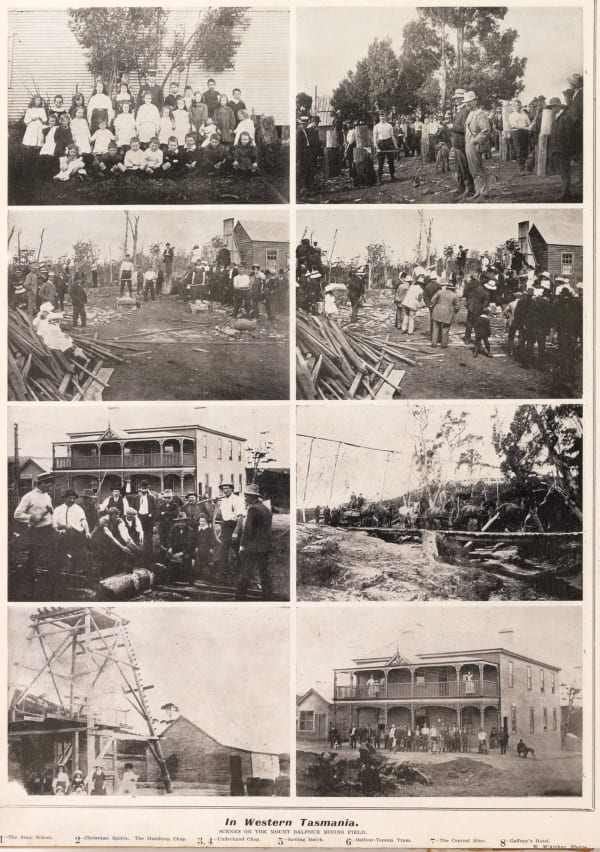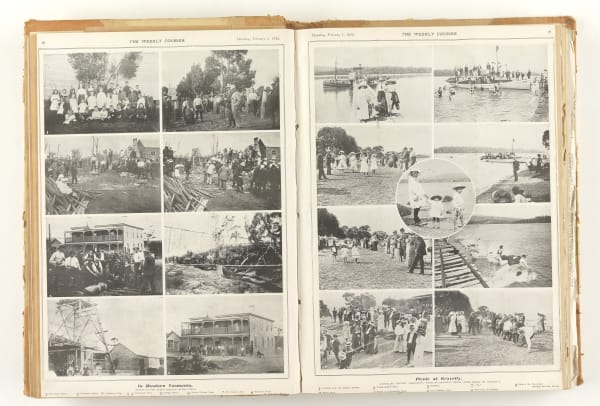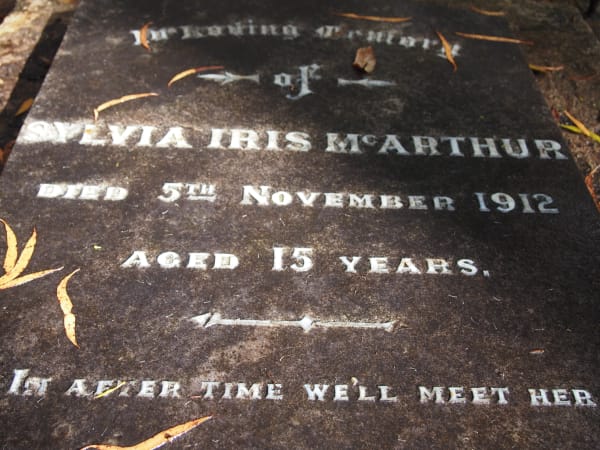Balfour is a ghost town, which is fitting for I come in search of a ghost.
Balfour is a desperately isolated mining town. Its short heyday, a hundred years ago, ended when it was all but abandoned after sewage seeped into the drinking water supply, causing typhoid to devastate the population. The physical remains of the settlement have mostly been reclaimed by the beautiful wild of the Tarkine, in its constant push to become rainforest again.
The ghost I seek is that of Sylvia McArthur, a school-age girl, and a keen amateur writer. Her father, William McArthur, was a machine operator in the Murray Brothers Copper Reward Mine, and a keen amateur photographer.
During 1912, Sylvia wrote regularly to Launceston’s The Weekly Courier. Her letters, accompanied by photographs taken by her father, were published in the newspaper’s “Young Folks’ Page”, edited by “Dame Durden”, who reportedly replied warmly to every published correspondence.
Sylvia’s letters and photographs provide the best record we have of Balfour as a thriving community. Her name became well-known to readers of the Young Folks’ Page. Then tragedy struck. Sylvia’s name appeared in the Weekly Courier for the last time on November 21, 1912, in a page 3 item announcing her death from typhoid. She was 15.
"My father took some photographs and told me I might send some to you. You will find my photograph in the school group. I am in the back row, the fourth from the left hand side; the laddie in front of me is my little brother Willie."

. . .
It is a six-hour drive from Hobart to Balfour. The final four kilometres is a four-wheel-drive only section of white gravel, rocks, mud, tree roots and huge puddles that together form the track from the Western Explorer Road, that links the North-West to the West, through the Tarkine.
I can’t complain. In 1911, Sylvia McArthur’s father got a job in the Reward Mine at Balfour and it took the family two weeks to travel from Zeehan.
Sylvia will tell you about the trip, as she told it to the readers of The Weekly Courier:
January 11, 1912
Dear Dame, I have not written to you before, although I have been going to do so for a long time. Shall I tell you about our trip from Zeehan to Balfour? I fancy our adventures would interest you.
Dad, mum, my two small brothers, my sister Mavis, and self, left Zeehan by the midday train for Burnie on October 17. We arrived at Burnie that evening, about 8 o'clock, very tired, although we enjoyed our ride.
Next morning, Mavis and I rose early to look at the sea. We went for a long walk along the beach before breakfast, and enjoyed it immensely. Punctually at 2:30 in the afternoon we left Burnie by the coach for Stanley; a long ride of 50 miles. The coach reached its destination at 10 o'clock, and I can tell you we were very glad to go to the hotel, where we had some supper, then went to bed.
The H.J.H., a sailing vessel, was leaving the next morning for Whale's Head, so dad made up his mind to go round on it. But the ship was unable to leave for four days, so we waited for it. The vessel left Stanley harbour on Sunday afternoon, so we were only able to go as far as Hunters Island that night. Before we were out of our bunks next morning the captain had started for Woolnorth. I liked the sea trip better on the second day than I did on the first. When we arrived there we went ashore in a small boat, then I had to walk three miles to the station.
The lady at the station was very good to us, and said we might remain there until the ship could go on to Whale's Head. The weather prevented us for nearly a week. Woolnorth was very nice; only very quiet compared with Zeehan.
The ship started from Woolnorth on Saturday early morning, and we arrived all safe in Whale's Head about 3 o'clock. As it was much nicer on deck than in the cabin we all lay down in a small boat, where we could at least get a breath of fresh air. The trucks that were to convey us to Balfour left the following day, about 10 o'clock. The tram line ran through some beautiful scenery. It was 2 o'clock when we reached Balfour, all prepared for a nice dinner. After we had rested we went for a walk about the town. Hoping you will find my letter fit for publishing, I remain, your sincere friend,
Sylvia M'Arthur,
Balfour

I left Devonport at 6am. The light oscillated between a slow golden and pink sunrise causing the rich cattle pasture of the North-West to illuminate its brilliant green and a dark brooding sky of thick misty rain that threatened to be the start of something greater. The land changed to rugged coastal scrub and button grass plains as I passed Arthur River. A wedge-tailed eagle showed off its three-metre wing span, standing on a power pole drying its wings in the wind ripping of the ocean.
I passed across a blackened planet where all you could see and smell was ashen earth left by the recent bushfires, but for little flashes of green where the sedges and ferns were beginning to re-emerge. Finally, I reached the track to Balfour, and bumped, rattled and splashed my way into the town.
An inviting, if not eerie, fire was sending thick, slow smoke into the misty rain. It was burning in the fireplace of the old pub in Alexander Street, though one wouldn’t know you were on the main street and the pub is gone. In its place is a communal shelter, built around the fireplace and chimney of the old pub. It was built by a local couple as a memorial for their son who took his own life in 2009 – he used to like hanging out at the old chimney. The shelter features old photos of the town, bits and pieces of story, couches, an old Land Rover as part of one wall, and a pool table. Warming my hands at the fire, lit by a friendly man visiting one of the residents, I imagined the pub still standing around me and the lives that fireplace has witnessed.
Two couples live in Balfour today, and one or two dwellings are used occasionally. None of these are original buildings, and all are hidden in their own patch of bush. There is no mains power, so personal generators are relied upon.
There is little obviously visible of the once busy little mining town. Forest succession seems sped up and more ruthless on the West Coast – the town is rapidly becoming rainforest. No complete original buildings remain. The old roads are now overgrown tracks, rusty machinery and rubble hide in the wet undergrowth, and the cemetery that once sat on a hillside overlooking the Frankland River now reveals but four gravestones that look out over dense forest.
One of the gravestones, lying flat on the earth, next to the largest tree, is that of Sylvia Iris McArthur. It reads, “In the after time we’ll meet her.”

As I looked for the Balfour Sylvia knew, I read her February 1912 letter to the The Weekly Courier:
In reply to your request to tell you all about Balfour, I shall be very pleased to comply so far as I am able. The township is situated on a piece of very good chocolate soil, which rises about 100 feet above the level of the button grass flats, and thus enables each place to have a good garden and be well drained. The scenery close to the house is very nice, on one side; as the Franklin (sic) River wends its way within one mile of the astern side, with numerous little fern gullies and glades running down towards the rugged bank of the stream. On the western side, right on to the sea; is open button grass plains, which for the most part of the year are uninteresting in appearance, but look nice at present, as there are many wild flowers blooming among the heath.
The business places consist of one hotel – the other was burnt down two days before Christmas – a store, a butcher's shop, one bakery, besides boarding houses and private buildings, a police station, and a state school.
Past the cemetery, I took the track down to the banks of the Frankland River, as Sylvia described doing in one of her letters. The river was calm as it slowly passed through the Tarkine. I sat on a long-since fallen tree, sculpted smooth by years of passing water and wondered, as I re-read her other letters, if it stood when Sylvia was here.
Sylvia wrote that her days passed slowly because she didn’t go to school: “I would very much like to go to school again only there are no big girls here, and I would be just as lonely as I am at home.” She expressed her townspeople’s hope that the Stanley-Balfour railway would soon be completed so they could be better connected to civilisation, and detailed the visit of the Premier, Sir Elliot Lewis, via the Trowutta Track. She critiqued the Empire Day celebrations, which were so disappointing compared to the “unforgettable” festivities she’d enjoyed in “bonnie” Zeehan and provided reviews of the town’s social events and of the many books she read. She wrote as the rain threatened to flood them out and lamented how tired her father got, working his 12-hour shifts, and of the photograph of herself in the cage going down into the Reward Mine, and how she was so white she looked like a ghost.
I wish Sylvia could have been told that more than 100 years after writing her letters the town would be gone, but someone would travel from Hobart carrying her words, retracing her steps and seeing where she rests, so that thousands more could read of her.

Sylvia’s letters reveal life in Balfour, the beauty of its surrounds, the loneliness and solidarity of isolation, and a time capsule of a distant Tasmanian era. She wrote of a concert given by schoolchildren to a crowded hall that, despite dreadful weather, was voted Balfour’s best concert yet and raised funds for a school library.
Then she wrote no more.
It must have been with tight chests and tearful eyes that the disparate yet deeply connected community of “Young Folks’ Page” readers found a letter telling of the death of the “dear child”. The letter was signed “Sylvia’s mother”. The letter said that that a few days before she had died Sylvia had asked her mother to bring her a copy of the newspaper, but she had been too ill to read. Sylvia had endured a great deal of pain with “fortitude and patience” and her death “seemed to cast a gloom over the place”.
I am not sure this gloom ever lifted from Balfour. Many died similarly and the town was abandoned. Or, perhaps it did, but I can’t separate my sadness for Sylvia from Balfour.
On the same day The Weekly Courier published the letter from Sylvia’s mother, it ran, in the centre of the Young Folks page, a poem written by William McArthur, Sylvia’s father:
A Message to Friends and Relations
In a lonely spot near Balfour,
On the West Coast far away,
Sylvia dear is laid to rest
To sleep till Judgement Day.
Never more will sisters see her,
Or her last farewell will hear:
To little Flo at Patersonia,
And at Hobart Gladys dear.
Never more she'll come to meet me,
Gaily tripping down the hill,
Catching hands with little Alty,
And her other brother, Will.
Nor will "chivvy chase" with Mavis,
In their girlish joyous glee,
Or will stroll along with mumma,
Linking arms so merrily.
For she's sleeping on the hillside,
Where the morning sun will shine,
'Mid a scene of ferns and dogwood,
Fringed with wild clematis vine,
With its tender fibres clinging,
Drawing close the boughs above,
As our hearts are drawn to Sylvie,
By the tender chords of love.
And the fiercest storm in winter,
As it rages on the shore,
Will not disturb you, dearest Sylvie,
Where you sleep for evermore.
A publisher once told James that when he is asked for his bio, he should say: “James writes subversive essays about important things.” James felt a bit awkward about saying this publicly, but secretly he liked it. He has written for many publications. His books are Essays from Near and Far, Walleah Press, 2014 and The Balfour Correspondent, Bob Brown Foundation, 2017.








